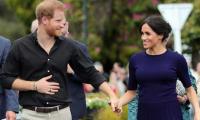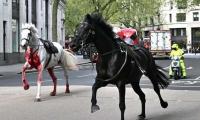BERLIN, Germany: The walls of the Bornholmer Huette pub were last painted in 1973, a light beige that has gradually cracked and darkened into a caramel brown from decades of cigarette smoke.
The “Huette,” as regulars call it, has been in Matthias Gehrhus’ family since 1954 and he doesn’t plan on changing it any time soon. Its Spartan styling recalls the days when it was a meeting place in communist East Berlin’s Prenzlauer Berg neighborhood, somewhere you’d go to catch up with an old friend over a cheap beer.
Gehrhus, 50, was born into that world and doesn’t want it back. But he also understands the feelings of many former East Germans that, 30 years after the Berlin Wall fell and communism collapsed, not everything has improved.
“It was a simple life then. Today, everything’s so complicated you collapse under the weight of it, and there’s always new regulations, new rules,” he said.“There was never a problem with money,” Gehrhus added, noting that life’s necessities were taken care of, even if travel abroad was restricted.
“Sure you couldn’t check out the world, but in the last 30 years I still haven’t checked out the rest of the world,” he said.A government report this year lauds the state of German reunification as “an impressive success story,” with per capita GDP in the former East Germany growing from 43% of that in West Germany in 1990 to 75% in 2018, and its unemployment rate falling from a crest of 18.7% in 2005 to 6.4% in October, not far above Germany’s 5% national unemployment figure.
But the report notes many former East Germans still perceive themselves as second-class citizens, something Chancellor Angela Merkel, who herself grew up in East Germany, had highlighted.
“Official German reunification is complete. But the unity of the Germans, their unity was not fully complete on Oct. 3, 1990, and that is still the case today,” she said last month. “German unity is not a state, completed and finished, but a perpetual process.”
About three months after the Nov. 9, 1989, opening of the Berlin Wall, West German Chancellor Helmut Kohl spoke of wanting quick German reunification — saying it could come as early as 1995, said historian Ilko-Sascha Kowalczuk.
Kohl’s prognosis and famous promise of “blooming landscapes” in the East seemed optimistic to many, who found it hard to believe that the Soviet Union — with a half-million troops in East Germany — would let it happen easily, said Kowalczuk, whose book on reunification, “The Takeover,” was published in German this year.
In fact, reunification came just months later, as much a shock to the 16 million East Germans as to the rest of the world.
“Nobody could imagine that unification could come so quickly,” Kowalczuk said. “Nobody in East Germany, nobody in the White House, nobody in Downing Street, nobody in the Elysee Palace, nobody in Bonn. Nobody could imagine that Moscow would give up its strategically most important outpost practically overnight for peanuts.”
The opening of the Berlin Wall was even more abrupt. The first border crossing to open was on Bornholmer Strasse, only a few hundred meters (yards) from the Bornholmer Huette pub.
The World Meteorological Organisation flag. — AFP FileGENEVA: Global temperatures hit record highs last year, and...
This image shows the outside view of the U.S. Senate. — AFP/FileWASHINGTON: Billions of dollars in foreign aid for...
Each year, many African migrants brave the perilous “Eastern Route” across the Red Sea and through war-scarred...
State Department US building can be seen in this picture. — AFP/FileWASHINGTON: The U.S. State Department’s annual...
Former US president Donald Trump. — AFP/FileNEW YORK: The judge overseeing Donald Trump’s criminal hush money...
Abortion-rights activists hold a protest on in Phoenix, USA. — AFP/File WASHINGTON: The idea of a doctor in the...







